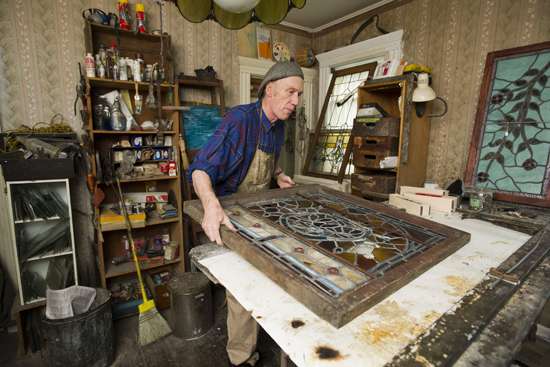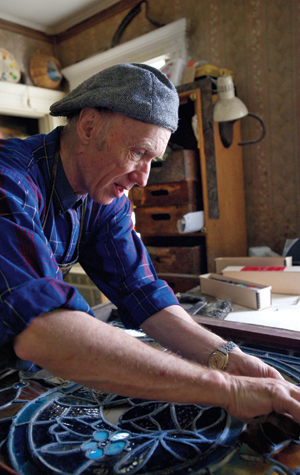Restoration Man
CGS alum repairs stained glass windows in homes, churches, restaurants

“Putting the window together is a sequence of events,” says Peter Ureneck. “It’s a meditation of sorts.” Photos by Cydney Scott
Peter Ureneck had a passing interest in stained glass until the 1970s, when a child’s sled cracked one of the long multicolored windows that flank the front door of his childhood home in Dorchester, Mass. He had been silk screen printing silhouetted original photographs of landscapes and seascapes on glass, and selling them as decorative objects, to be hung in a window. Ureneck figured he already had some of the materials, and the skills, and he set about repairing the sidelight in the triple-decker, where he still lives.
Today, the stunning 32-inch-by-12-inch window, made of opalescent, beveled clear, and cathedral—or colored—glass in hues of blue, green, yellow, and red, shows no sign of damage, and Ureneck (CGS’69) has made a career of the work. As the owner of Dorchester Stained Glass, he repairs windows in homes, restores them in local churches, and salvages, fixes, and sells them at flea markets and in antique stores.
Ureneck is self-taught, except for the guidance he regularly sought in the late 1970s and early 1980s from the old-timers who had studios on St. Botolph Street in Boston’s Back Bay. “That was the old Stained Glass Row,” he says. “They all moved out when the Orange Line was built adjacent to it.”

In the early 1990s, he recalls, he stumbled upon a restoration project while rehabbing a house in Dorchester. “It was a stained glass window that someone had taken out and was tossing in the weekly trash,” he says. “Lead is very malleable, so it was folded up and literally stuffed into a plastic bucket.” He took it home, built a workbench, and fixed it. “Stained glass is visual, but it is also a very tactile kind of thing,” he says. “Eventually, I put it together in an archaeological sense; with a couple of missing pieces, I had to surmise what they were for.”
When he finished, Ureneck brought the window to a local antique store, and two or three months later it sold. “That was the start of a business relationship that allowed me to sell a couple of dozen windows over 20 years to local antique shops,” he says.
In that time, several churches have hired him to do repairs on their stained glass windows, among them St. Peter’s, St. Mark’s, and the First Parish Church, all in Dorchester, as well as the First Congregational Church of Braintree, Mass.
One day last summer, Ureneck was restoring a 34-inch-by-34-inch Victorian-era stained glass window he had acquired. He’s transformed a first-floor bedroom into a studio, with a waist-high bench and dozens of shelves laden with glass of all sizes, sorted by color, which he buys from retailers or hobbyists who want to sell their stash. The tools of his trade are all within reach: hammers, scrapers, glass cutters, grozing pliers, a soldering iron, a lathkin to smooth the lead “caming”—the grooved strips into which Ureneck coaxes each piece of glass—and lead knives to cut it.

The Victorian window, which is bowed, must be perfectly flat before Ureneck can begin the repairs. To do that, he uses his own invention: long pieces of metal placed at the front and back of the frame and held in place by screws and shims. As he gradually tightens the screws, the window slowly flattens. He calls the tool a de-bower, and he can also use it to flatten a window without removing it from a building or house. “It saves the restorer from having to take the window out, putting in a temporary window, carrying it carefully to the bench, fixing it, carrying it back, and reinstalling it,” he says. “Carrying stained glass is risky.”
Just over a year ago Ureneck was granted a patent on his de-bower from the US Patent and Trademark Office. He hopes to find a company that will manufacture or market the tool, or both.
Once the Victorian window lays flat, Ureneck will replace the cracked or missing glass and the caming, push the cement between the glass and the lead, and clean the excess. He’ll search his inventory of glass for the closest match and cut the pieces to the appropriate dimensions. “Putting the window together is a sequence of events; you can’t put one thing ahead of the other,” he says. “It’s a meditation of sorts.”

Ureneck attempts to keep as many of the original features as possible when restoring a window. Some stained glass artisans, he says, believe it’s better to disassemble the window and replace all of the lead caming. “I have a conservationist approach to stained glass restoration,” he says. “If it isn’t broken, I won’t fix it. For instance, if you replace a section of lead caming, you’ve lost the window’s connection to the past. This is because the lead used at different times originated from varying sources, each with its own mineral markers: Colonial leaded glass from New Jersey, Victorian from out West, and so forth.”
Ureneck inspects the window on his bench. “This lead looks like it’s pretty well intact,” he says. He estimates the one-of-a-kind 80-plus-piece window will fetch $1,800.
“If I had another occupation, it would be an emergency room technician,” Ureneck says. “These things come in a total disaster, all but ready for the great beyond. And here we have a situation where this window will enjoy a new life. That’s where I get satisfaction, as maudlin as that might sound.”
A version of this story originally ran in the fall 2013 edition of Bostonia.

Comments & Discussion
Boston University moderates comments to facilitate an informed, substantive, civil conversation. Abusive, profane, self-promotional, misleading, incoherent or off-topic comments will be rejected. Moderators are staffed during regular business hours (EST) and can only accept comments written in English. Statistics or facts must include a citation or a link to the citation.